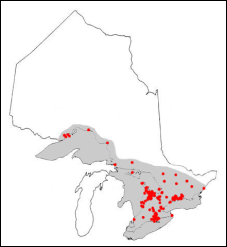Brown Trout
Information about the Brown Trout (Salmo trutta), a cold-water fish that was introduced and naturalized in Ontario.

Great Lakes brown trout (Illustration Credit: U.S. Fish and Wildlife Service)
What it looks like
- brown back
- silvery or pale brown sides with dark spots, often with a lighter ring
- white belly
- tail may have a few faint spots
- white mouth and gums
- the only salmon or trout with orange on adipose fin (small fin between dorsal fin and tail)
- leading anal fin ray extends the length of the fin
- short, stocky caudal peduncle (where body meets tail)
- Great Lakes brown trout are larger than the inland lakes variety
- in Great Lakes variety, the back may be blue/green and spots may be smaller
Size
- length: 20-60 centimetres (8-24 inches)
- weight: 0.5-4.5 kilograms (1-9.5 pounds)
- Ontario record: 15.6 kilograms (34.4 pounds)
Similar fish
Where it is found
Range

Inland lakes brown trout (Illustration Credit: Wisconsin Department of Natural Resources)
- introduced into Ontario streams from Europe in 1913
- now found throughout the Great Lakes and their tributaries, and streams in southern Ontario
- most abundant in Lake Ontario, Georgian Bay, Great Lakes tributaries, inland stocked creeks
- use Fish ON-Line, an interactive mapping tool, to find specific lakes and rivers
Habitat
- pools or ponds fed by streams
- quiet, calm waters
- turbulent, fast-flowing streams
Find a fishing spot with Fish ON-Line
Angling tips
- feed most aggressively at night
- cast from piers and break-walls
- use brook trout bait to catch the inland lakes variety
- target the Great Lakes variety by trolling
- look for the Great Lakes variety in shallower waters than rainbow trout and Chinook salmon
- in the fall, catch the Great Lakes variety in tributaries using small spinners or plugs, or small baits beneath floats
Common baits
- spinners, spoons, jigs
- small plugs, including those imitating minnows
- flies, worms, roe
Updated: January 11, 2023
Published: July 18, 2014